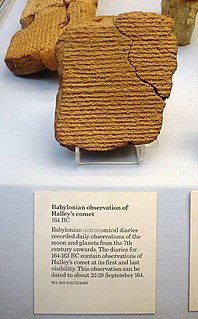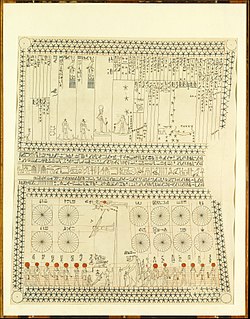
Astrology is a pseudoscience that claims to discern information about human affairs and terrestrial events by studying the movements and relative positions of celestial objects. Astrology has been dated to at least the 2nd millennium BCE, and has its roots in calendrical systems used to predict seasonal shifts and to interpret celestial cycles as signs of divine communications. Many cultures have attached importance to astronomical events, and some—such as the Hindus, Chinese, and the Maya—developed elaborate systems for predicting terrestrial events from celestial observations. Western astrology, one of the oldest astrological systems still in use, can trace its roots to 19th–17th century BCE Mesopotamia, from where it spread to Ancient Greece, Rome, the Arab world and eventually Central and Western Europe. Contemporary Western astrology is often associated with systems of horoscopes that purport to explain aspects of a person's personality and predict significant events in their lives based on the positions of celestial objects; the majority of professional astrologers rely on such systems.
Astronomy is the oldest of the natural sciences, dating back to antiquity, with its origins in the religious, mythological, cosmological, calendrical, and astrological beliefs and practices of prehistory: vestiges of these are still found in astrology, a discipline long interwoven with public and governmental astronomy. It was not completely separated in Europe during the Copernican Revolution starting in 1543. In some cultures, astronomical data was used for astrological prognostication. The study of astronomy has received financial and social support from many institutions, especially the Christian Church, which was its largest source of support between the 12th century to the Enlightenment.

The zodiac is a belt-shaped region of the sky that extends approximately 8° north or south of the ecliptic, the apparent path of the Sun across the celestial sphere over the course of the year. The paths of the Moon and visible planets are within the belt of the zodiac.

Western astrology is the system of astrology most popular in Western countries. Western astrology is historically based on Ptolemy's Tetrabiblos, which in turn was a continuation of Hellenistic and ultimately Babylonian traditions.

Jyotisha or Jyotishya is the traditional Hindu system of astrology, also known as Hindu astrology, Indian astrology and more recently Vedic astrology. The term Hindu astrology has been in use as the English equivalent of Jyotiṣa since the early 19th century, whereas Vedic astrology is a relatively recent term, entering common usage in the 1970s with self-help publications on Āyurveda or yoga.

In classical antiquity, the seven classical planets or seven luminaries are the seven moving astronomical objects in the sky visible to the naked eye: the Moon, Mercury, Venus, the Sun, Mars, Jupiter, and Saturn. The word planet comes from two related Greek words, πλάνης planēs and πλανήτης planētēs, both with the original meaning of "wanderer", expressing the fact that these objects move across the celestial sphere relative to the fixed stars. Greek astronomers such as Geminus and Ptolemy often divided the seven planets into the Sun, the Moon, and the five planets.
The Celtic calendar is a compilation of pre-Christian Celtic systems of timekeeping, including the Gaulish Coligny calendar, used by Celtic countries to define the beginning and length of the day, the week, the month, the seasons, quarter days, and festivals.

Astrological beliefs in correspondences between celestial observations and terrestrial events have influenced various aspects of human history, including world-views, language and many elements of social culture.

Astrology and astronomy were archaically treated together, and were only gradually separated in Western 17th century philosophy with the rejection of astrology. During the later part of the medieval period, astronomy was treated as the foundation upon which astrology could operate.

In many languages, the names given to the seven days of the week are derived from the names of the classical planets in Hellenistic astronomy, which were in turn named after contemporary deities, a system introduced by the Roman Empire during Late Antiquity. In some other languages, the days are named after corresponding deities of the regional culture, beginning either with Sunday or with Monday. The seven-day week was adopted in early Christianity from the Hebrew calendar, and gradually replaced the Roman nundinal cycle as the new religion spread. Sunday remained the first day of the week, being considered the Lord's Day, while the Jewish sabbath remained the seventh. Emperor Constantine adopted the seven-day week for official use in CE 321, making the Day of the Sun a legal holiday. In the international standard ISO 8601, Monday is treated as the first day of the week.
Indian astronomy has a long history stretching from pre-historic to modern times. Some of the earliest roots of Indian astronomy can be dated to the period of Indus Valley Civilization or earlier. Astronomy later developed as a discipline of Vedanga, or one of the "auxiliary disciplines" associated with the study of the Vedas, dating 1500 BCE or older. The oldest known text is the Vedanga Jyotisha, dated to 1400–1200 BCE.

Greek astronomy is astronomy written in the Greek language in classical antiquity. Greek astronomy is understood to include the Ancient Greek, Hellenistic, Greco-Roman, and Late Antiquity eras. It is not limited geographically to Greece or to ethnic Greeks, as the Greek language had become the language of scholarship throughout the Hellenistic world following the conquests of Alexander. This phase of Greek astronomy is also known as Hellenistic astronomy, while the pre-Hellenistic phase is known as Classical Greek astronomy. During the Hellenistic and Roman periods, much of the Greek and non-Greek astronomers working in the Greek tradition studied at the Museum and the Library of Alexandria in Ptolemaic Egypt.

Babylonian astronomy was the study or recording of celestial objects during the early history of Mesopotamia.
Often called lunar mansion, a lunar station or lunar house is a segment of the ecliptic through which the Moon passes in its orbit around the Earth. The concept was used by several ancient cultures as part of their calendrical system.

Babylonian astrology was the first known organized system of astrology, arising in the second millennium BC.

Historically, astrological and astronomical symbols overlapped. Frequently used symbols include signs of the zodiac and classical planets. These originate from medieval Byzantine codices. Their current form is a product of the European Renaissance. Other symbols for astrological aspects are used in various astrological traditions.

Some medieval Muslims took a keen interest in the study of astrology, despite the Islamic prohibitions: partly because they considered the celestial bodies to be essential, partly because the dwellers of desert-regions often travelled at night, and relied upon knowledge of the constellations for guidance in their journeys. After the advent of Islam, the Muslims needed to determine the time of the prayers, the direction of the Kaaba, and the correct orientation of the mosque, all of which helped give a religious impetus to the study of astronomy and contributed towards the belief that the heavenly bodies were influential upon terrestrial affairs as well as the human condition. The science dealing with such influences was termed astrology, a discipline contained within the field of astronomy. The principles of these studies were rooted in Arabian, Persian, Babylonian, Hellenistic and Indian traditions and both were developed by the Arabs following their establishment of a magnificent observatory and library of astronomical and astrological texts at Baghdad in the 8th century.

Egyptian astronomy began in prehistoric times, in the Predynastic Period. In the 5th millennium BCE, the stone circles at Nabta Playa may have made use of astronomical alignments. By the time the historical Dynastic Period began in the 3rd millennium BCE, the 365 day period of the Egyptian calendar was already in use, and the observation of stars was important in determining the annual flooding of the Nile.

Budha is a Sanskrit word that connotes the planet Mercury. Budha, in Puranic Hindu legends, is also a deity.

Planets in astrology have a meaning different from the astronomical understanding of what a planet is. Before the age of telescopes, the night sky was thought to consist of two very similar components: fixed stars, which remained motionless in relation to each other, and "wandering stars", which moved relative to the fixed stars over the course of the year.










